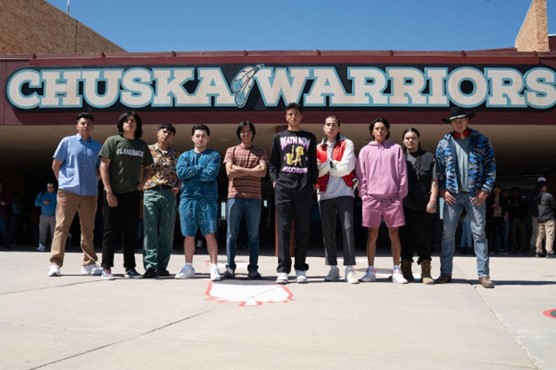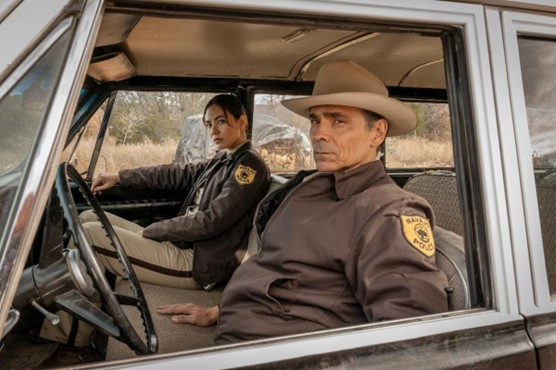New Mexico Film Office Celebrates Film and Television Production on Pueblos and Tribal Lands
Press Release From the New Mexico Film Office
Thursday, November 30, 2023
Santa Fe, NM – In honor of Native American Heritage Month, the New Mexico Film Office (NMFO) celebrates film and television production on Pueblo and Tribal lands in the state.
The state’s film incentive program continues to propel it’s the growth of the industry in these Native sovereignties. Since 2019, 15 New Mexico Tribal lands and Pueblos have been home to 17 productions, and New Mexico continues to be a hub for Native American talent, filmmakers, and content creation.
The New Mexico Film Office works with the Pueblos, Tribes, and productions to ensure that filming is done respectfully and with cultural sensitivity. The office also provides technical assistance to support film production infrastructure and workforce.
“Indigenous voices in film are powerful, and New Mexico is proud to support Native filmmakers, production, and the stories they tell,” Gov. Lujan Grisham said. “The film industry also provides good-paying jobs and significant economic opportunities for the 23 Nations, Tribes, and Pueblos in New Mexico.”
According to a multitude of sources, the first film ever made in New Mexico was filmed at Isleta Pueblo. “Indian Day School,” an approximate 30-second film, was created in 1898 and produced by Thomas Edison.
Tribal lands and Pueblos including Zia Pueblo, Zuni Pueblo, Cochiti Pueblo, Ohkay Owingeh, Santa Clara Pueblo, Santa Ana Pueblo, Taos Pueblo, San Felipe Pueblo, Santo Domingo Pueblo, Nambé Pueblo, Navajo Nation, Mescalero Apache Tribe, Tesuque Pueblo, To’jajilee (Cañoncito Reservation), and Sandia Pueblo have all been home to film and television productions since 2019.
“We are pleased to highlight the many Pueblos and Tribal lands in New Mexico that are working with and benefiting from the film industry,” Amber Dodson, Director of NMFO, said. “New Mexico’s Native American communities offer a unique array of spectacular locations that attract filmmakers with projects of all scopes and sizes. The film office remains committed to collaborating with Pueblos and Tribes, as they are already a vital part of the state’s film industry and want to spur or increase partnership. Our state’s film incentive has been and continues to be very conducive to supporting production on Tribal lands and Pueblos.”
New Mexico’s Film Production Tax Credit provides the same eligibility criteria for state, local, and Tribal governments, and it can work equally well on Tribal lands. For example, a local government, including a Tribe, Pueblo, or Nation, can lease public property to a private company, and the private company may then license the use of the public property to a film production company. The receipts are taxable in New Mexico and, therefore, would be eligible as a direct production expenditure in the calculation of the credit. Further, the qualifications required regarding taxation in the state and specifics as per statute, that define a direct production expenditure, apply the same way whether on Tribal lands or not.
“The Taxation and Revenue Department encourages economic development on Tribal lands and ensures that Tribes and their members have the same opportunities afforded by the Film Tax Credit as all New Mexicans have,” Secretary Schardin Clarke said.

The cast of Netflix’s “Rez Ball.” Photo courtesy of Netflix.
Notable productions filmed on Pueblos and Tribal lands in recent years include:
· Netflix’s “Chupa” (Zia Pueblo)
· AMC’s “Dark Winds” Seasons 1 and 2 (Tesuque Pueblo)
· Netflix’s “Rez Ball” (Navajo Nation)
· “The Best Man” (Mescalero Apache)
· Warner Bros. Discover’s “Roswell, New Mexico” Seasons 1-4 (Santa Domingo, Santa Clara)
· ABC’s The Bachelorette” (Santa Ana Pueblo)
· NBCUniversal’s “News of the World” (Ohkay Owingeh)
· Lionsgate’s “End of the Road” (Zia Pueblo and Cochiti Pueblo)
· Bron Studios’ “Surrounded” (Santa Clara Pueblo)

Zahn McClarnon as Joe Leaphorn and Jessica Matten as Bernadette Manuelito in AMC’s “Dark Winds.” Photos courtesy of AMC.
The popular series “Dark Winds” has been based at Tesuque Pueblo for two seasons and was recently renewed for a third season. Chris Eyre (Cheyenne and Arapaho, “Smoke Signals”) directed several episodes. The series is produced by John Wirth (“Hell on Wheels”), Robert Redford (“The Mustang”), George R.R. Martin (“Game of Thrones”), Zahn McClarnon (Hunkpapa Lakota), Graham Roland (Chickasaw Nation, “Tom Clancy’s Jack Ryan”), and more to tell the story of Lieutenant Joe Leaphorn and Deputy Chee as they uncover crimes and mysteries, not only in work but also within themselves. This production alone has generated notable spend in Tesuque Pueblo and will continue to grow the local infrastructure.
“Filming ‘Dark Winds’ on Tribal lands has been an incredible honor and privilege,” Eyre stated. “It is important to tell this story on Tribal lands with Native American actors. I am grateful to the Tesuque Pueblo for allowing us to film on their land, to show some places that haven’t been seen before, and to let the industry know Tribes are open for business. Mostly, I hope it will inspire other Native American filmmakers to tell their stories.”
NMFO supports workforce development programs and events for above and below-the-line crafts, focusing on fostering talent from local Tribal lands and Pueblos. Recent initiatives include the Senator John Pinto Memorial Filmmakers Grant, administered by NMFO, which awarded 20 grants to Native filmmakers. The highly competitive Stowe Story Labs’ “New Voices | New Mexico” screenwriting incubator, organized and funded by NMFO for two consecutive years, has seen three Native/Indigenous participants, including Stanley Bain, Carmen Tsabetsaye, and Thomas Gray.
“It was a great experience and so satisfying to hear feedback and encouragement from peers and mentors who understood my project,” Tsabetsaye said. “[Stowe Story Labs] also gave me confidence that I was going in the right direction and to continue pushing my project forward.”
NMFO hosted an in-person event in honor of Native American Heritage Month on November 29th, highlighting the progress and continued need for Native American content creation. The panel brought together Native and Indigenous thought leaders in the film industry to discuss the importance of Native American stories on the screen, representation in casting, and why New Mexico is a leader in this space.
Panelists included Producer Jhane Meyers (Comanche Nation, “Prey”), Senator John Pinto grant recipient and filmmaker Joshua Zuni (Zuni Pueblo, “Rude Girl”), Casting Director Angelique Midthunder (“Reservation Dogs”), Actor Ryan Begay (Diné, “Dark Winds”), Camel Rock Studios Stage Manager Peter Romero (Tesuque Pueblo), with moderation by Executive Producer Bird Runningwater (Mescalero Apache Tribe, “Fancy Dance”). A video stream of the panel can be found here.
NMFO is also hosting a production assistant training exclusively for the local Native American community on December 3. A production assistant, also known as a PA, is an entry-level crew position and a great way to springboard into the industry as the role provides on-the-job training and valuable experience on-set. NMFO is partnering with Silver Heart Productions for this free, one-day virtual training. Participants must be part of the New Mexico Native American community, over 18, interested, and available to work immediately. Registration forms can be found here, and spots will be filled on a first-come, first-served basis.
To explore filming opportunities on Pueblo and Tribal lands, connect with the respective film liaisons listed here. NMFO’s comprehensive directory of locations and production resources can also be accessed here.